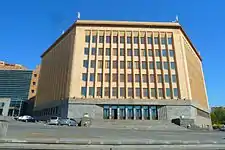Mark Grigorian (Armenian: Մարկ Գրիգորյան, Russian: Марк Владимирович Григорян; April 29, 1900 – January 10, 1978) was a Soviet Armenian Neoclassical architect.
Life
Born in Nakhichevan-on-Don, southern Russia, Grigorian moved to Soviet Armenia in 1924. He graduated from the Yerevan State University in 1928 and was appointed as the chief architect of Yerevan in 1939, succeeding Nikolay Buniatyan.[1]
Works
Grigorian designed (or co-designed) several major landmarks of Yerevan, including the buildings where the three branches of the government are housed—all on Baghramyan Avenue, and three of the five buildings around Republic Square, along with Eduard Sarapian.
Below are listed his most notable works, all in Yerevan:
| Building | History and use |
|---|---|
National Assembly of Armenia  |
Its construction began in 1948 and was completed in 1950. It housed the Central Committee of the Communist Party of Armenian SSR until May 1991, when the Supreme Council (parliament) of the Republic of Armenia moved in. It now serves as the building of the National Assembly of Armenia, the country's legislature.[2] |
Presidential Palace  |
Completed in 1951, it initially served the Council of Ministers of the Armenian Soviet Republic and later as the building of the Presidium of the Supreme Council of Armenian SSR. It has been Armenia's Presidential Palace since independence in 1991,[3] except for a brief period in 2018, when it was the residence of the Prime Minister.[4] |
Trade Unions and Communications Building  |
Its construction began in 1933[5] and was completed in 1956. It was designed by Grigorian and Eduard Sarapian.[6] The building was home to Ministry of Transport and Communications until 2016.[7] |
Hotel Armenia  |
It was completed in 1958 according to the design of Grigorian and Eduard Sarapian.[6][8] The hotel was called Armenia during the Soviet period. A luxury hotel, Armenia Marriott Hotel Yerevan it is considered the flagship hotel of Armenia.[9][10] It has 380 rooms.[11] |
Matenadaran  |
Build between 1945 and 1958, except a pause from 1947 to 1953 due to unavailability of skilled laborers and carpenters, the building of the Matenadaran, the Institute of Ancient Manuscripts, was officially opened in 1959.[12] |
Constitutional Court of Armenia  |
The building of the Constitutional Court of Armenia was designed by Grigorian and Henrik Arakelian. It was completed in 1974.[13] |
Museums Building  |
The buildings of the History Museum of Armenia and the National Gallery of Armenia began in the 1950s with the National Gallery building being completed in 1977.[6][14] It was designed by Grigorian and Eduard Sarapian.[6] |
Political Enlightenment House  |
Completed in 1979, the building served as the Political Enlightenment House of the Central Committee of the Armenian Communist Party until 1991, when it was given by the state to the American University of Armenia.[15][16] It was designed by Grigorian and Henrik Arakelian.[17] |
References
- ↑ Babayan, L. (1977). "Մարկ Գրիգորյան [Grigorian Mark]". Armenian Soviet Encyclopedia Volume 3 (in Armenian). pp. 226-227.
- ↑ "Building of the National Assembly". parliament.am. National Assembly of the Republic of Armenia. Archived from the original on 24 April 2019.
- ↑ "History". president.am. The Office to the President of the Republic of Armenia. Archived from the original on 24 April 2019.
- ↑ "Armenian parliament agrees to move president's residence to Baghramyan 26". news.am. 22 November 2018.
- ↑ Tigranian, Edmond (1985). "Երևանի Վ. Ի. Լենինի անվան հրապարակի քաղաքաշինական ասպեկտները" [The town-building aspects of V. I. Lenin square in Yerevan]]. Lraber Hasarakakan Gitutyunneri (in Armenian). № 9 (9): 27.
- 1 2 3 4 Government of the Republic of Armenia (2 November 2004). "Հայաստանի Հանրապետության Երևան քաղաքի պատմության և մշակույթի անշարժ հուշարձանների պետակական ցուցակ [List of historical and cultural monuments of Yerevan]". arlis.am (in Armenian). Armenian Legal Information System. Archived from the original on 5 August 2016.
- ↑ "Շրջայց Երևանով. Հանրապետության հրապարակ [Yerevan Walking Tour: Republic Square]". armenianheritage.org (in Armenian). Armenian Monuments Awareness Project.
- ↑ Gevorgian, A. O. (1979). "Yerevan". The Great Soviet Encyclopedia.
The main architectural ensemble of the city is Lenin Square, at which several streets converge. On the square are a monument to V. I. Lenin (cast bronze, 1940, sculptor S. D. Merkurov), the Government House of the Armenian SSR (1926-41, A. I. and G. A. Tamanian), the second Government House (1955, S. A. Safarian, V. A. Arevshatian, and R. S. Israelian), the Armenian Historical Museum (1975), the Hotel Armenia (1958), and the building of the Communications Ministry and the Trade Union Council (1956-58); the last three were designed by M. V. Grigorian and E. A. Sarapian.
view article online - ↑ "Armenia Marriott Hotel Yerevan". marriott.com.
- ↑ Karanian, Matthew; Kurkjian, Robert (2002). Edge of Time: Traveling in Armenia and Karabagh. Stone Garden Productions. p. 78. ISBN 9780967212029.
The country's flagship hotel is still the massive Hotel Armenia, which faces Republic Square in the heart of the city. In 2003 the hotel will be renamed the Armenia Marriott Hotel Yerevan to reflect its new ownership.
- ↑ "Marriott". Asian Hotel & Catering Times. 26: 7. 2001.
...the 380-room Armenia Marriott Hotel Yerevan.
- ↑ Grigorian, M. V. (1960). "Մատենադարանի շենքի կառուցման մասին [On construction of the Matenadaran building]" (PDF). Banber Matenadarani (in Armenian). 5: 12. Archived (PDF) from the original on 2018-07-21. Retrieved 2019-04-24.()
- ↑ "Constitutional Court". otheryerevan.am.
Architect: Mark Grigoryan, Henrik Arakelyan Built in 1974
- ↑ "1947-1991 Հայաստանի պետական պատկերասրահ [1947-1991 The State Gallery of Armenia]". gallery.am (in Armenian). National Gallery of Armenia.
- ↑ "Հայաստանի կոմունիստական կուսակցություն [Communist Party of Armenia]". Armenian Soviet Encyclopedia Volume 13 Soviet Armenia (in Armenian). 1987. p. 224.
- ↑ "Որոշում Հայաստանի ամերիկյան համալսարան ստեղծելու մասին". arlis.am (in Armenian). Armenian Legal Information System. Archived from the original on 25 January 2016.
- ↑ "American University of Armenia". otheryerevan.am.
Architect: Mark Grigoryan, Henrik Arakelyan Built in 1979
This article is issued from Wikipedia. The text is licensed under Creative Commons - Attribution - Sharealike. Additional terms may apply for the media files.